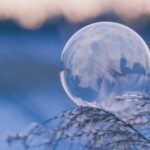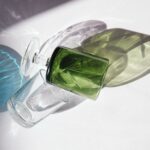Have you ever wondered what makes bubbles in water so mesmerizing? They may seem simple and innocuous, but there’s a captivating science behind those shimmering spheres. In this article, we will dive into the intriguing world of bubbles in water and unravel the mysterious forces at play. From the physics of bubble formation to the chemistry of surface tension, we will explore the intricate mechanisms that make these little wonders come to life. So, grab a glass of water, sit back, and get ready to embark on a scientific journey into the enchanting realm of bubbles.

The science behind bubbles in water
Bubbles in water have always captivated our curiosity. They can be found in a variety of settings, from our daily glass of water to the soothing ambiance of a hot bath. But have you ever wondered what causes these bubbles to form? In this article, we will delve into the fascinating scientific principles behind the formation of bubbles in water and explore the factors that influence their appearance and behavior.
When it comes to bubbles in water, there are two main types to consider: those caused by air bubbles and those that form during boiling. Air bubbles are typically the culprits behind cloudy or white water, particularly in colder temperatures. This phenomenon is harmless and occurs due to the presence of atmospheric gases, such as nitrogen and oxygen, dissolved in the water. As the temperature drops, the solubility of air in water increases, causing the dissolved gases to come out of the solution and form bubbles within the glass. It’s almost like the water is exhaling tiny pockets of air as it chills.
Boiling water presents another opportunity for bubbles to make their appearance. Contrary to popular belief, the bubbles that form when water is boiled are not made of water vapor; rather, they consist of air bubbles resulting from the dissolved gases coming out of the solution. As the water temperature rises, the solubility of these gases decreases, leading to the release of tiny bubbles that give boiling water its lively appearance.
It’s fascinating to note that the formation of bubbles in water is influenced by changes in atmospheric pressure and temperature. As the pressure increases or the temperature decreases, the solubility of air in water also increases. That’s why you may notice more bubbles forming on exceptionally cold days. So, the next time you see bubbles dancing in your glass of water or witness them swiftly forming while boiling water for tea, remember the role that pressure and temperature play in this captivating phenomenon.
It’s essential to emphasize that bubbles in water are completely harmless and have no impact on the quality or safety of drinking water. They are simply a natural consequence of the physical properties of water and the dissolved gases it contains. So, feel free to enjoy your glass of water, even if it’s filled with a playful display of bubbles.
To further explore the science behind bubbles in water, you can refer to reputable online sources like [usgs.gov], [scientificamerican.com], [scienceabc.com], and [thoughtco.com]. These sources provide more detailed information on the topic and can satisfy your curiosity about the intricacies of bubbles in water.
In conclusion, the science behind bubbles in water unveils a captivating world of physical phenomena. Understanding the role of dissolved gases, changes in atmospheric pressure, and temperature variations helps us appreciate the beauty and simplicity of this everyday occurrence. So, the next time you encounter bubbles in your glass of water or witness them forming during boiling, take a moment to marvel at the wonders of science that are happening right before your eyes.
“From the chills of winter to the bubbling tea kettle, bubbles in water are nature’s way of revealing the intriguing dance between gases and liquids.”
Bubbles in water are a mesmerizing sight to behold. The way they dance and float, creating a playful display of colors and shapes, is truly captivating. If you’re looking to learn more about this fascinating phenomenon, look no further. Dive into the world of bubbles in water by clicking here: Bubbles in water. This link will take you on a journey where you can explore the science behind bubbles, their formation, and the various factors that influence their behavior. Get ready to be enthralled as you uncover the secrets hidden beneath the surface of bubbling water.

FAQ
Question 1
What causes bubbles in water to form?
Answer 1
Bubbles in water can be caused by air bubbles, which cause cloudy or white water. This is harmless and is more likely to occur when it is very cold outside. Tap water also contains atmospheric gases, such as nitrogen and oxygen, dissolved in it. When water sits out for a few hours, its temperature rises slightly, causing the dissolved gases to come out of the water and form bubbles inside the glass.
Question 2
Are bubbles in water harmful to drink?
Answer 2
No, bubbles in water are completely harmless and do not affect the quality or safety of drinking water. The formation of bubbles is a natural occurrence and does not pose any health risks.
Question 3
What causes bubbles to form when water is boiled?
Answer 3
When water is boiled, the bubbles that form are actually air bubbles from the dissolved gases, such as nitrogen and oxygen, coming out of the solution. As the water reaches its boiling point, these gases are released and create the visible bubbles.
Question 4
How does atmospheric pressure and temperature affect bubble formation in water?
Answer 4
The formation of bubbles in water is influenced by atmospheric pressure and temperature changes. The solubility of air in water increases as water pressure increases or water temperature decreases. Therefore, when it is cold outside, bubbles may form more readily due to the increased solubility of air in water.
Question 5
Where can I find more information about bubbles in water?
Answer 5
For more detailed information about bubbles in water, you can refer to online sources such as usgs.gov, scientificamerican.com, scienceabc.com, and thoughtco.com. These sources provide in-depth explanations about the science behind bubbles and their interactions with water.
















